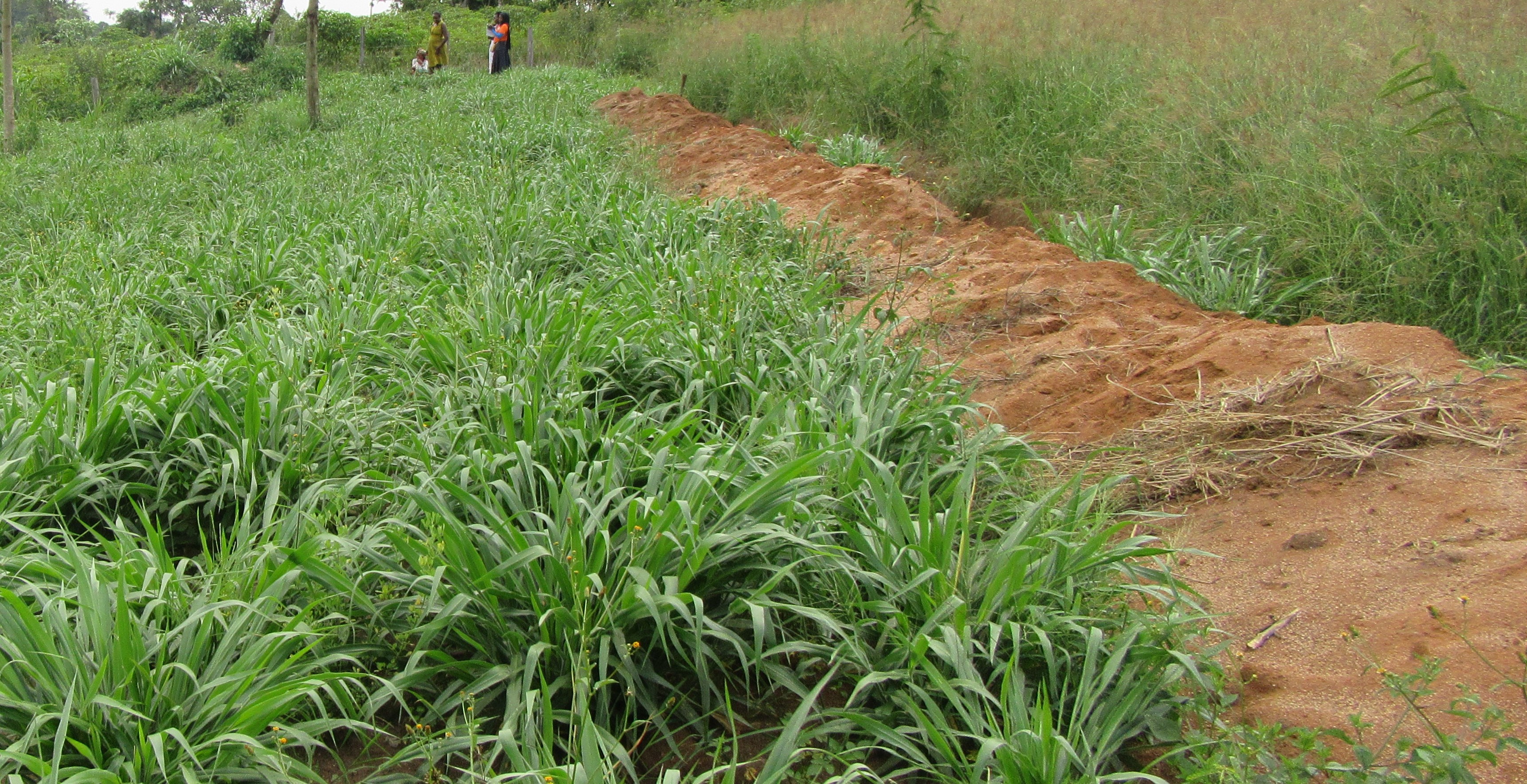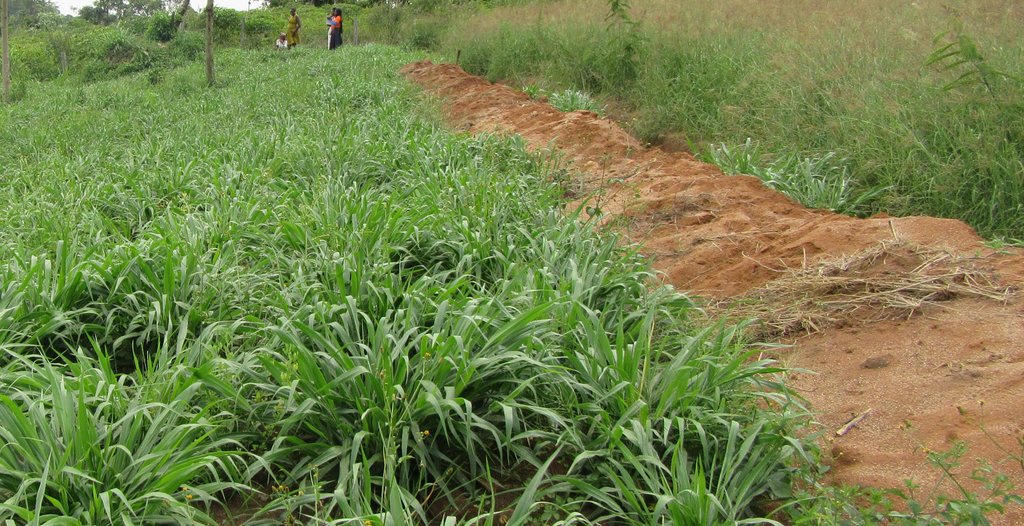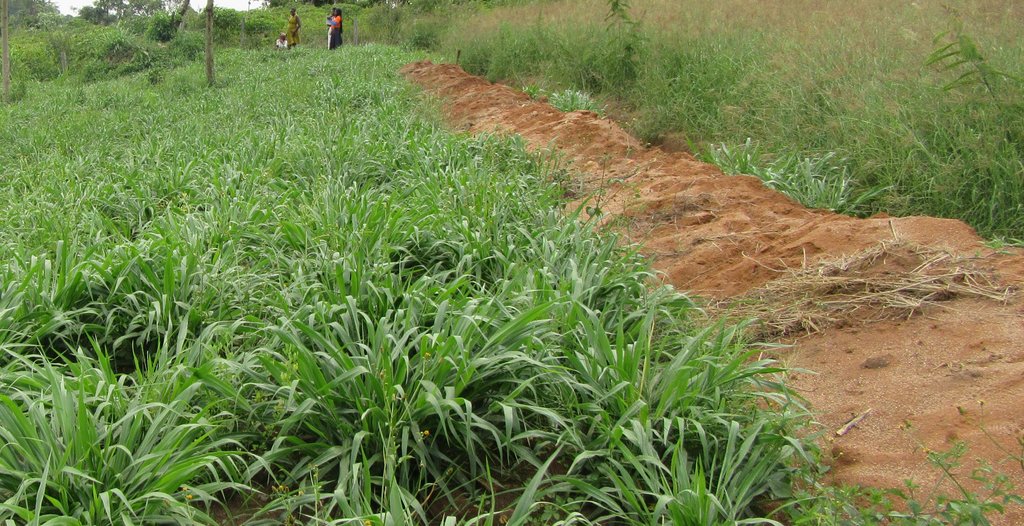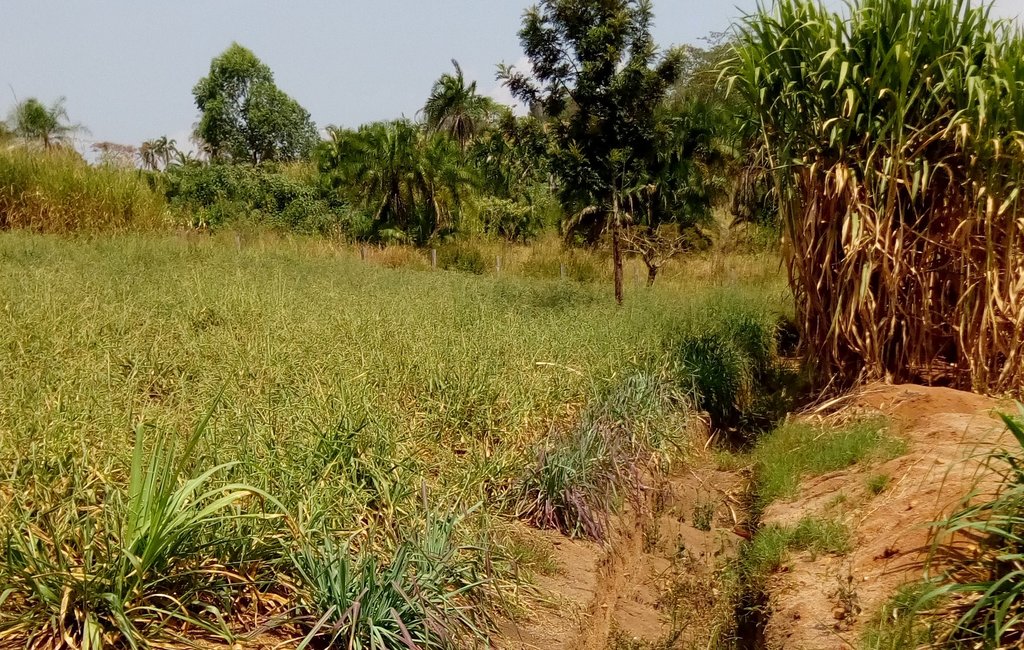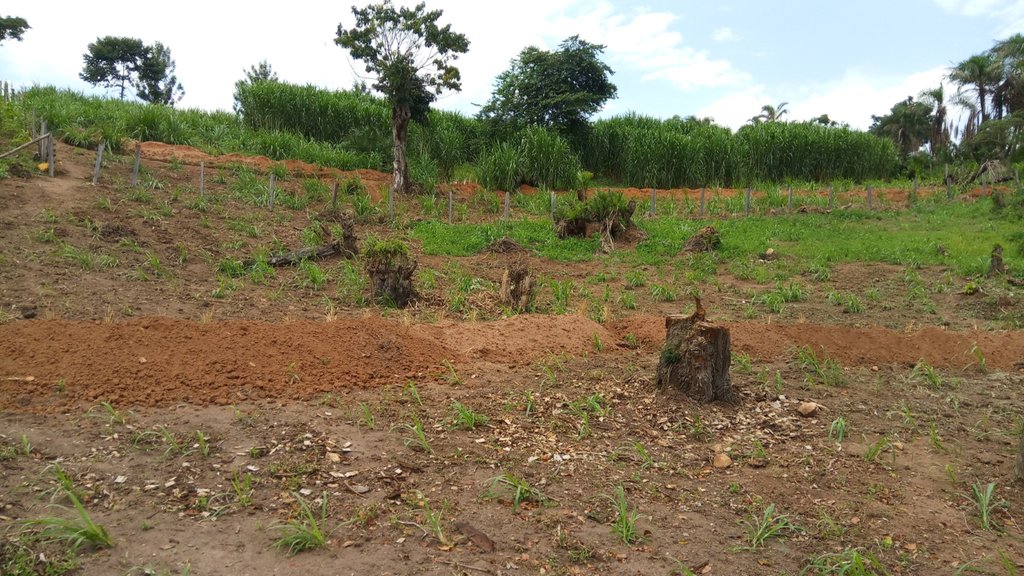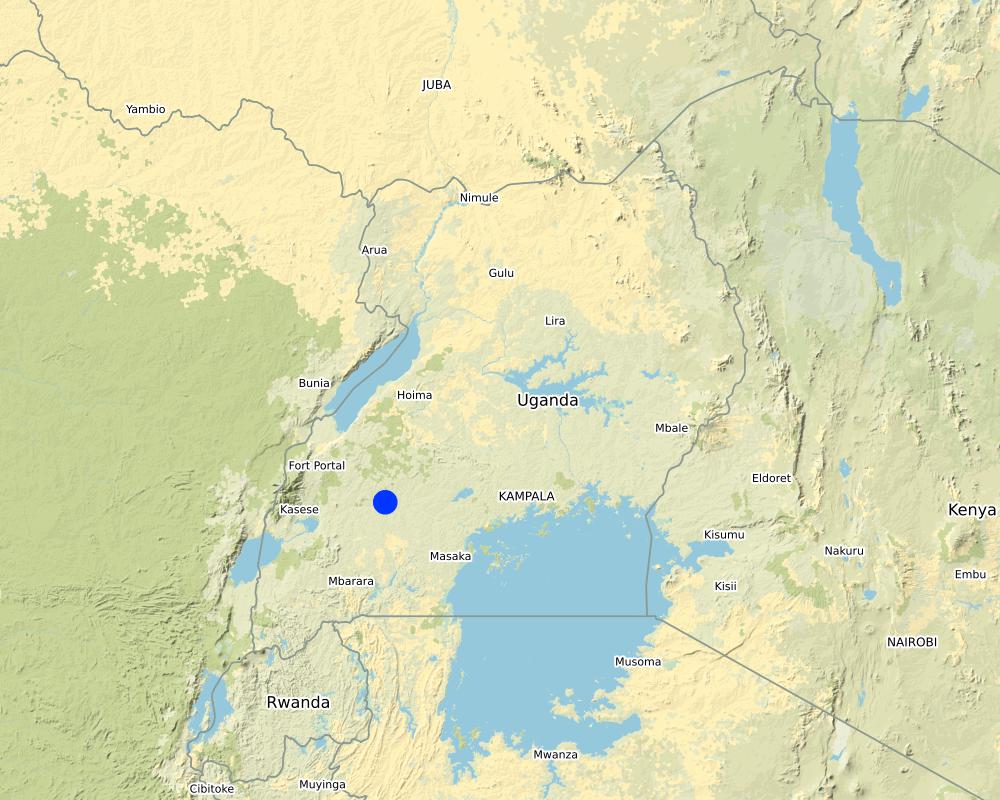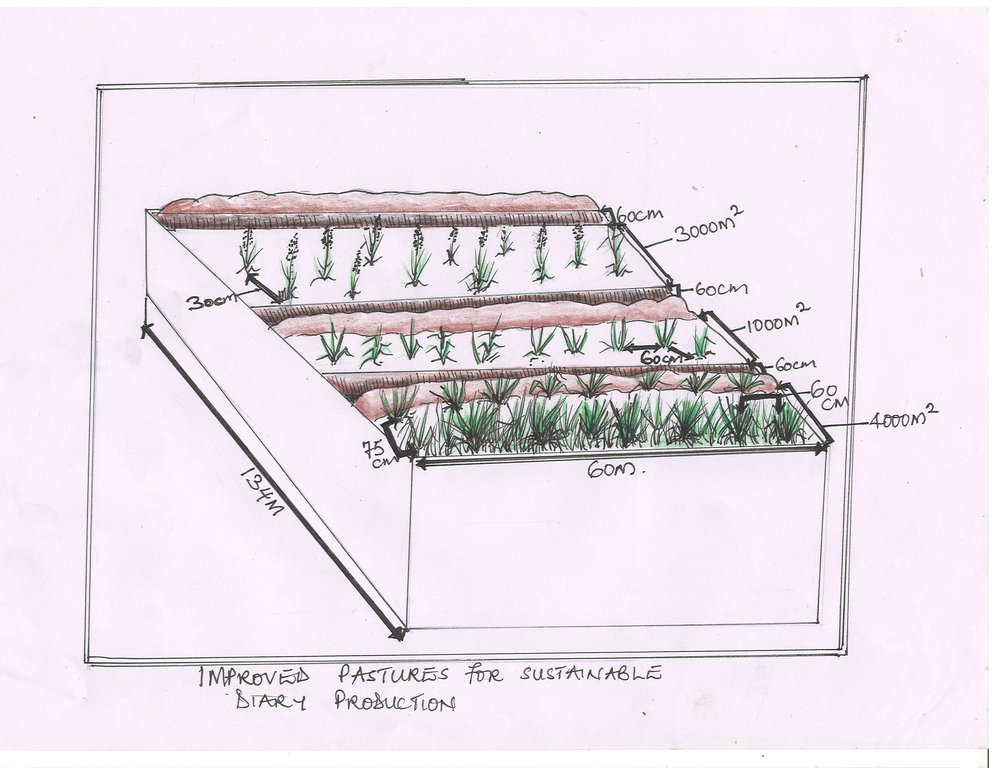Growing Improved Pastures for Sustainable Dairy Production [ยูกันดา]
- ผู้สร้างสรรค์:
- การอัพเดท:
- ผู้รวบรวม: Jalia Namakula
- ผู้เรียบเรียง: Kamugisha Rick Nelson
- ผู้ตรวจสอบ: Nicole Harari, Udo Höggel
Ebinyansi byokurisa ente zamate
technologies_3362 - ยูกันดา
ดูส่วนย่อย
ขยายทั้งหมด ย่อทั้งหมด1. ข้อมูลทั่วไป
1.2 รายละเอียดที่ติดต่อได้ของผู้รวบรวมและองค์กรที่เกี่ยวข้องในการประเมินและการจัดเตรียมทำเอกสารของเทคโนโลยี
วิทยากรหลัก
ผู้ใช้ที่ดิน:
Mugisha Robert
Diary for Life
Kyegeggwa District
ยูกันดา
ชื่อของโครงการซึ่งอำนวยความสะดวกในการทำเอกสารหรือการประเมินเทคโนโลยี (ถ้าเกี่ยวข้อง)
Scaling-up SLM practices by smallholder farmers (IFAD)ชื่อขององค์กรซึ่งอำนวยความสะดวกในการทำเอกสารหรือการประเมินเทคโนโลยี (ถ้าเกี่ยวข้อง)
National Agricultural Research Organisation (NARO) - ยูกันดา1.3 เงื่อนไขการใช้ข้อมูลที่ได้บันทึกผ่านทาง WOCAT
วันที่เก็บรวบรวมข้อมูล(ภาคสนาม) :
17/10/2018
ผู้รวบรวมและวิทยากรหลักยอมรับเงื่อนไขเกี่ยวกับการใช้ข้อมูลที่ถูกบันทึกผ่านทาง WOCAT:
ใช่
1.4 การเปิดเผยเรื่องความยั่งยืนของเทคโนโลยีที่ได้อธิบายไว้
เทคโนโลยีที่ได้อธิบายไว้นี้เป็นปัญหาของความเสื่อมโทรมโทรมของที่ดินหรือไม่ จึงไม่ได้รับการยอมรับว่าเป็นเทคโนโลยีเพื่อการจัดการที่ดินอย่างยั่งยืน:
ไม่ใช่
แสดงความคิดเห็น:
Pastures act as fallows therefore they improve soil quality over time
2. การอธิบายลักษณะของเทคโนโลยี SLM
2.1 การอธิบายแบบสั้น ๆ ของเทคโนโลยี
คำจำกัดความของเทคโนโลยี:
Growing Improved Pastures (chloris gayana, brachiaria mulato and pernisetum purpurem) is a technology promoted among small, meduim scale farmers in Kyegegwa District, Western Uganda for sustainable dairy production, improved nutrition and sustainable land management.
2.2 การอธิบายแบบละเอียดของเทคโนโลยี
คำอธิบาย:
Improved pastures comprising of fast growing nutritious grasses or legumes are generally said to be more productive than the local native pastures, because they have higher protein, carbohydrate levels and are easy to digest.
The pastures on the farm documented are established on a 2 acre piece of land located on a gently sloping area of about 20% in Kyegegwa District which experiences an average annual rainfall of about 1200 mm. The field covers the entire landscape and is neighboured by a cassava plantation. Within the same field, contour trenches were established to separate one pasture field from the other, and to also prevent soil and nutrient loss within the field. Pastures planted include Chloris gayana (rhodes grass), Brachiaria mulato (signal grass) and Pennisetum (napier grass). All grasses are native to East Africa.
Each pasture type on each plot is planted as a pure stand; the Chloris field lies on a 3000 m2 plot size, the Brachiaria field lies on 1000 m2 plot size and the Pennisetum field lies on a 4000 m2 plot size.
-Chloris gayana was planted at a spacing of 30 cm inter row and broadcasted within the rows, the seeds were mixed with sand before they were broadcasted. Thereafter the seeds were covered lightly with soils to enable easy germination of the tiny seeds.
-Brachiaria mulato was planted at a spacing of 60X 60cm
-Napier was planted at 75x 60cm.
Prior to establishment of the pastures, the plots were cleared of the bush, ploughed twice and harrowed to make a fine seed bed before planting. Two tonnes of animal manure was added. The following equipment was used:
-Hand hoes
-3 slashers
-A spirit level for leveling the contour trenches
Planting material for all the grasses was provided by the Rwebitaba Zonal Agricultural Research and Development Institute (RwebiZARDI) in form of root tillers for Brachiaria, seeds for Chloris and cuttings for the Pennisetum grass.
Kyegegwa is one of the districts where conflicts between livestock keepers and crop farmers are increasing. This kind of pressure does not allow free range grazing any more. Therefore the pastures planted were not only to provide better quality and quantity feeds for the dairy project throughout the year but also to reduce on conflicts with neighbours. Chloris gayana yields between 20-27t DM/ha and was planted to provide hay. It is drought tolerant, has a high regeneration capacity, easy to digest and is rich in carbohydrates, while Bracharia mulato is also palatable and often used in a cut & carry system. Bracharia is easy to conserve as compared to other grasses and is rich in proteins. Napier grass was planted for its early maturity, regeneration capacity, especially during the rainy season and just like Brachiaria easy to makes silage. The improved pastures are suitable for both cut & carry and grazing and they are tolerant to drought therefore providing a sustainable feed base for the diary all year round. The pastures were also planted to act as a fallow, thereby also improving soil fertility.
Establishment costs were estimated to be at UGX 1,396,000 while maintenance costs were estimated to be at UGX 320,000 per annum. Improved pastures are advantageous because they provide more nutrients than local pastures; Chloris provides more carbohydrates whereas Brachiaria and Penisetum provide more protein. Pastures rehabilitate degraded land by acting as vegetation cover for longer periods hence reducing soil erosion and increasing soil fertility. They control broad leaved weeds and a small piece of land is used to cut and carry for stock. Improved pastures require fencing as well as improved management practices such as a good soil fertility plan.
2.3 รูปภาพของเทคโนโลยี
2.4 วีดีโอของเทคโนโลยี
ความคิดเห็น/อธิบายสั้นๆ:
Video showing improved pastures
วันที่:
17/10/2017
สถานที่:
Kamwenge District, South Western Uganda
ชื่อผู้ถ่ายวีดีโอ:
Jalia Namakula
2.5 ประเทศภูมิภาค หรือสถานที่ตั้งที่เทคโนโลยีได้นำไปใช้และได้รับการครอบคลุมโดยการประเมินนี้
ประเทศ:
ยูกันดา
ภูมิภาค/รัฐ/จังหวัด:
Western Uganda
ข้อมูลจำเพาะเพิ่มเติมของสถานที่ตั้ง :
Kamwenge Town Council
แสดงความคิดเห็น:
The practice was established in Kyegegwa town council, Kyegegwa District, Western Uganda.
Map
×2.6 วันที่การดำเนินการ
ระบุปีที่ใช้:
2016
2.7 คำแนะนำของเทคโนโลยี
ให้ระบุว่าเทคโนโลยีถูกแนะนำเข้ามาอย่างไร:
- ทางโครงการหรือจากภายนอก
ความคิดเห็น (ประเภทของโครงการ เป็นต้น) :
The improved pastures were promoted by Rwebitaba ZARDI through the Kamwenge District Local government
3. การจัดประเภทของเทคโนโลยี SLM
3.1 วัตถุประสงค์หลักของเทคโนโลยี
- ปรับปรุงการผลิตให้ดีขึ้น
- ลด ป้องกัน ฟื้นฟู การเสื่อมโทรมของที่ดิน
3.2 ประเภทของการใช้ที่ดินในปัจจุบันที่ได้นำเทคโนโลยีไปใช้

พื้นที่ปลูกพืช
- การปลูกพืชล้มลุกอายุปีเดียว
พืชหลัก (พืชเศรษฐกิจและพืชอาหาร):
Cassava, maize
แสดงความคิดเห็น:
The farm is neighboured by a cassava plantation and a maize field
ถ้าการใช้ที่ดินมีการเปลี่ยนแปลงเนื่องมาจากการนำเทคโนโลยีไปปฏิบัติใช้ ให้ระบุการใช้ที่ดินก่อนนำเทคโนโลยีไปปฏิบัติใช้:
The field was previously used for maize cultivation
3.3 ข้อมูลเพิ่มเติมเกี่ยวกับการใช้ที่ดิน
การใช้น้ำของที่ดินที่มีการใช้เทคโนโลยีอยู่:
- น้ำฝนร่วมกับการชลประทาน
แสดงความคิดเห็น:
There is a wetland at the foot of the slopes where water is drawn and used to irrigate the pastures, in addition an irrigation system is being constructed to enable sustainable pasture production.
จำนวนของฤดูเพาะปลูกต่อปี:
- 2
ระบุ:
Pastures are harvested twice a year
3.4 กลุ่ม SLM ที่ตรงกับเทคโนโลยีนี้
- การจัดการปศุสัตว์และทุ่งหญ้าเลี้ยงสัตว์
3.5 กระจายตัวของเทคโนโลยี
ระบุการกระจายตัวของเทคโนโลยี:
- กระจายไปอย่างสม่ำเสมอในพื้นที่
ถ้าหากว่าเทคโนโลยีได้มีการกระจายออกไปอย่างสม่ำเสมอในพื้นที่ ให้ระบุปริมาณพื้นที่ที่ได้รับการครอบคลุมถึง:
- < 0.1 ตร.กม.(10 เฮกตาร์)
แสดงความคิดเห็น:
The field lies on 0.8 ha of land
3.6 มาตรการ SLM ที่ประกอบกันเป็นเทคโนโลยี

มาตรการอนุรักษ์ด้วยวิธีพืช
- V2: หญ้าและไม้ยืนต้น
แสดงความคิดเห็น:
Improved pastures planted include Signal grass (Brachiaria mulato), Rhodes grass (Chloris gayana), and Napier grass (pernnisetum Purpurem)
3.7 รูปแบบหลักของการเสื่อมโทรมของที่ดินที่ได้รับการแก้ไขโดยเทคโนโลยี

การกัดกร่อนของดินโดยน้ำ
- Wt (Loss of topsoil): การสูญเสียดินชั้นบนหรือการกัดกร่อนที่ผิวดิน

การเสื่อมโทรมของดินทางด้านเคมี
- Cn (Fertility decline): ความอุดมสมบูรณ์และปริมาณอินทรียวัตถุในดินถูกทำให้ลดลงไป (ไม่ได้เกิดจากสาเหตุการกัดกร่อน)

การเสื่อมโทรมของดินทางด้านชีวภาพ
- Bc (Reduction of vegetation cover): การลดลงของจำนวนพืชที่ปกคลุมดิน
- Bl (Loss of soil life): การสูญเสียสิ่งมีชีวิตในดิน
แสดงความคิดเห็น:
The pastures are a perennial crop that act as a soil cover for longer periods of time, preventing soil and nutrient loss therefore improving soil fertility and productivity
3.8 การป้องกัน การลดลง หรือการฟื้นฟูความเสื่อมโทรมของที่ดิน
ระบุเป้าหมายของเทคโนโลยีกับความเสื่อมโทรมของที่ดิน:
- ป้องกันความเสื่อมโทรมของที่ดิน
- ฟื้นฟูบำบัดที่ดินที่เสื่อมโทรมลงอย่างมาก
แสดงความคิดเห็น:
Pastures, because of their longivity, reduce soil erosion and therefore improve soil fertility
4. ข้อมูลจำเพาะด้านเทคนิค กิจกรรมการนำไปปฏิบัติใช้ ปัจจัยนำเข้า และค่าใช้จ่าย
4.1 แบบแปลนทางเทคนิคของเทคโนโลยี
4.2 ข้อมูลจำเพาะด้านเทคนิคและการอธิบายแบบแปลนทางเทคนิค
The technical drawing shows improved pastures established on 0.8 ha of land (8000 m2), planted with Brachiaria (planted on 1000 m2 plot size at a spacing of 60×60cm), Chloris guyana, planted on a 3000 m2 plot size at a spacing of 30cm inter row and seed broadcasted within the row. Napier grass planted on a 4000 m2 plot size at a spacing of 75×60cm, using plant cuttings. The pastures are planted in three different blocks with each block separated by a contour trench of 2 m width and 60 m length. The Brachiaria grows up to a height of 50 cm, Chloris to around 90 cm and Napier grass can grow up to a 2 m.
4.3 ข้อมูลทั่วไปเกี่ยวกับการคำนวณปัจจัยนำเข้าและค่าใช้จ่าย
ให้ระบุว่าค่าใช้จ่ายและปัจจัยนำเข้าได้รับการคำนวณอย่างไร:
- ต่อพื้นที่ที่ใช้เทคโนโลยี
ระบุขนาดและหน่วยพื้นที่:
2 acres
อื่นๆ หรือสกุลเงินประจำชาติ (ระบุ):
UGX
ระบุอัตราแลกเปลี่ยนจากดอลลาร์สหรัฐเป็นสกุลเงินท้องถิ่น (ถ้าเกี่ยวข้อง) คือ 1 เหรียญสหรัฐ =:
3800.0
ระบุค่าเฉลี่ยของค่าจ้างในการจ้างแรงงานต่อวัน:
7000
4.4 กิจกรรมเพื่อการจัดตั้ง
| กิจกรรม | ประเภทของมาตรการ | ช่วงเวลาดำเนินการ | |
|---|---|---|---|
| 1. | Slashing | ด้วยการจัดการ | Once |
| 2. | Ploughing | จัดการพืช | Once |
| 3. | Field Marking | จัดการพืช | Once |
| 4. | Planting | จัดการพืช | Once |
4.5 ค่าใช้จ่ายของปัจจัยนำเข้าที่จำเป็นสำหรับการจัดตั้ง
| ปัจจัยนำเข้า | หน่วย | ปริมาณ | ค่าใช้จ่ายต่อหน่วย | ค่าใช้จ่ายทั้งหมดต่อปัจจัยนำเข้า | %ของค่าใช้จ่ายที่ก่อให้เกิดขึ้นโดยผู้ใช้ที่ดิน | |
|---|---|---|---|---|---|---|
| แรงงาน | Slashing | day | 3.0 | 100000.0 | 300000.0 | 100.0 |
| แรงงาน | Ploughing | day | 3.0 | 120000.0 | 360000.0 | 100.0 |
| แรงงาน | Planting | day | 2.0 | 100000.0 | 200000.0 | 100.0 |
| แรงงาน | Excavating contour trenches | meter | 10000.0 | 100.0 | ||
| อุปกรณ์ | Slasher | piece | 3.0 | 7000.0 | 21000.0 | 100.0 |
| อุปกรณ์ | Hoes | piece | 3.0 | 10000.0 | 30000.0 | 100.0 |
| อุปกรณ์ | Chisel | piece | 1.0 | 10000.0 | 10000.0 | 100.0 |
| อุปกรณ์ | Spirit level | piece | 1.0 | 20000.0 | 20000.0 | 100.0 |
| วัสดุด้านพืช | Wheelbarrow | piece | 1.0 | 75000.0 | 75000.0 | 100.0 |
| วัสดุด้านพืช | Panga | piece | 3.0 | 10000.0 | 30000.0 | 100.0 |
| วัสดุด้านพืช | Brachiaria | bags | 5.0 | 50000.0 | 250000.0 | |
| วัสดุด้านพืช | Chloris gayana | kg | 1.0 | 100000.0 | 100000.0 | |
| วัสดุด้านพืช | Napier grass | piece | 10.0 | 50000.0 | 500000.0 | |
| ปุ๋ยและสารฆ่า/ยับยั้งการเจริญเติบโตของสิ่งมีชีวิต (ไบโอไซด์) | Manure | bag | 20.0 | 10000.0 | 200000.0 | 100.0 |
| ค่าใช้จ่ายทั้งหมดของการจัดตั้งเทคโนโลยี | 2096000.0 | |||||
ถ้าผู้ใช้ที่ดินรับภาระน้อยกว่า 100% ของค่าใช้จ่าย ให้ระบุว่าใครเป็นผู้รับผิดชอบส่วนที่เหลือ:
Labour and equipment costs were covered by the land user
แสดงความคิดเห็น:
Planting material was provided by the Town Council
4.6 การบำรุงรักษาสภาพหรือกิจกรรมที่เกิดขึ้นเป็นประจำ
| กิจกรรม | ประเภทของมาตรการ | ช่วงระยะเวลา/ความถี่ | |
|---|---|---|---|
| 1. | Weeding | จัดการพืช | once a month |
| 2. | Pesticide application | จัดการพืช | once a month |
| 3. | Cutting | ด้วยการจัดการ | twice a month |
| 4. | Fertiliser application | จัดการพืช | twice annually |
4.7 ค่าใช้จ่ายของปัจจัยนำเข้าและกิจกรรมที่เกิดขึ้นเป็นประจำที่ต้องการการบำรุงรักษา (ต่อปี)
| ปัจจัยนำเข้า | หน่วย | ปริมาณ | ค่าใช้จ่ายต่อหน่วย | ค่าใช้จ่ายทั้งหมดต่อปัจจัยนำเข้า | %ของค่าใช้จ่ายที่ก่อให้เกิดขึ้นโดยผู้ใช้ที่ดิน | |
|---|---|---|---|---|---|---|
| แรงงาน | Weeding | piece | 1.5 | 80000.0 | 120000.0 | 100.0 |
| แรงงาน | Spraying | piece | 1.5 | 10000.0 | 15000.0 | 100.0 |
| แรงงาน | Cutting | piece | 1.5 | 10000.0 | 15000.0 | 100.0 |
| อุปกรณ์ | Panga | piece | 3.0 | 10000.0 | 30000.0 | 100.0 |
| อุปกรณ์ | Knapsack | piece | 1.0 | 120000.0 | 120000.0 | 100.0 |
| ปุ๋ยและสารฆ่า/ยับยั้งการเจริญเติบโตของสิ่งมีชีวิต (ไบโอไซด์) | Pesticides | liter | 1.0 | 20000.0 | 20000.0 | 100.0 |
| ค่าใช้จ่ายทั้งหมดของการบำรุงรักษาสภาพเทคโนโลยี | 320000.0 | |||||
ถ้าผู้ใช้ที่ดินรับภาระน้อยกว่า 100% ของค่าใช้จ่าย ให้ระบุว่าใครเป็นผู้รับผิดชอบส่วนที่เหลือ:
The seed and planting material were given by the RwebitabaZARDI through the Kyegegwa Town Council
แสดงความคิดเห็น:
Establishment of the improved pastures was done in partnership with the RwebiZARDI and Kyegegwa town council. The Agreement was for the development partners to provide seed and the beneficiary to incur establishment and maintenance costs .
4.8 ปัจจัยสำคัญที่สุดที่มีผลกระทบต่อค่าใช้จ่าย
ปัจจัยสำคัญที่สุดที่มีผลกระทบต่อค่าใช้จ่ายต่างๆ:
Availability of labour
5. สิ่งแวดล้อมทางธรรมชาติและของมนุษย์
5.1 ภูมิอากาศ
ฝนประจำปี
- < 250 ม.ม.
- 251-500 ม.ม.
- 501-750 ม.ม.
- 751-1,000 ม.ม.
- 1,001-1,500 ม.ม.
- 1,501-2,000 ม.ม.
- 2,001-3,000 ม.ม.
- 3,001-4,000 ม.ม.
- > 4,000 ม.ม.
ระบุปริมาณน้ำฝนเฉลี่ยรายปี (ถ้ารู้) :หน่วย ม.ม.
1200.00
ข้อมูลจำเพาะ/ความคิดเห็นเรื่องปริมาณน้ำฝน:
Rainfall onsets in March-June
Second season starts in August- December
เขตภูมิอากาศเกษตร
- ชื้น
Uganda has a tropical climate
5.2 สภาพภูมิประเทศ
ค่าเฉลี่ยความลาดชัน:
- ราบเรียบ (0-2%)
- ลาดที่ไม่ชัน (3-5%)
- ปานกลาง (6-10%)
- เป็นลูกคลื่น (11-15%)
- เป็นเนิน (16-30%)
- ชัน (31-60%)
- ชันมาก (>60%)
ธรณีสัณฐาน:
- ที่ราบสูง/ที่ราบ
- สันเขา
- ไหล่เขา
- ไหล่เนินเขา
- ตีนเนิน
- หุบเขา
ระดับความสูง:
- 0-100 เมตร
- 101-500 เมตร
- 501-1,000 เมตร
- 1,001-1,500 เมตร
- 1,501-2,000 เมตร
- 2,001-2,500 เมตร
- 2,501-3,000 เมตร
- 3,001-4,000 เมตร
- > 4,000 เมตร
5.3 ดิน
ค่าเฉลี่ยความลึกของดิน:
- ตื้นมาก (0-20 ซ.ม.)
- ตื้น (21-50 ซ.ม.)
- ลึกปานกลาง (51-80 ซ.ม.)
- ลึก (81-120 ซ.ม.)
- ลึกมาก (>120 ซ.ม.)
เนื้อดิน (ดินชั้นบน):
- ปานกลาง (ดินร่วน ทรายแป้ง)
เนื้อดินล่าง (> 20 ซ.ม.ต่ำจากผิวดิน):
- ปานกลาง (ดินร่วน ทรายแป้ง)
อินทรียวัตถุในดิน:
- ปานกลาง (1-3%)
5.4 ความเป็นประโยชน์และคุณภาพของน้ำ
ระดับน้ำใต้ดิน:
<5 เมตร
น้ำไหลบ่าที่ผิวดิน:
ดี
คุณภาพน้ำ (ที่ยังไม่ได้บำบัด):
เป็นน้ำใช้เพื่อการเกษตรเท่านั้น (การชลประทาน)
ความเค็มของน้ำเป็นปัญหาหรือไม่:
ไม่ใช่
กำลังเกิดน้ำท่วมในพื้นที่หรือไม่:
ใช่
บ่อยครั้ง:
เป็นครั้งเป็นคราว
ความคิดเห็นและข้อมูลจำเพาะเพิ่มเติมเรื่องคุณภาพและปริมาณน้ำ:
The water table is high
5.5 ความหลากหลายทางชีวภาพ
ความหลากหลายทางชนิดพันธุ์:
- ต่ำ
ความหลากหลายของแหล่งที่อยู่:
- ต่ำ
ความคิดเห็นและข้อมูลจำเพาะเพิ่มเติมของความหลากหลายทางชีวภาพ:
The field has only grasses
5.6 ลักษณะของผู้ใช้ที่ดินที่นำเทคโนโลยีไปปฏิบัติใช้
อยู่กับที่หรือเร่ร่อน:
- อยู่กับที่
แนวทางการตลาดของระบบการผลิต:
- ผสม (การเลี้ยงชีพ/ทำการค้า)
รายได้ที่มาจากนอกฟาร์ม:
- 10-50% ของรายได้ทั้งหมด
ระดับของความมั่งคั่งโดยเปรียบเทียบ:
- รวย
เป็นรายบุคคล/ครัวเรือน:
- เป็นรายบุคคล/ครัวเรือน
ระดับของการใช้เครื่องจักรกล:
- การใช้เครื่องจักรหรือเครื่องยนต์
เพศ:
- ชาย
อายุของผู้ใช้ที่ดิน:
- ผู้เยาว์
ระบุลักษณะอื่นๆที่เกี่ยวข้องของผู้ใช้ที่ดิน:
The farmer owns a general merchandise shop in Kyegegwa town
5.7 พื้นที่เฉลี่ยของที่ดินที่เป็นเจ้าของหรือเช่าโดยผู้ใช้ที่ดินที่นำเทคโนโลยีไปปฏิบัติใช้
- < 0.5 เฮกตาร์
- 0.5-1 เฮกตาร์
- 1-2 เฮกตาร์
- 2-5 เฮกตาร์
- 5-15 เฮกตาร์
- 15-50 เฮกตาร์
- 50-100 เฮกตาร์
- 100-500 เฮกตาร์
- 500-1,000 เฮกตาร์
- 1,000-10,000 เฮกตาร์
- >10,000 เฮกตาร์
พิจารณาว่าเป็นขนาดเล็ก กลาง หรือขนาดใหญ่ (ซึ่งอ้างอิงถึงบริบทระดับท้องถิ่น):
- ขนาดเล็ก
แสดงความคิดเห็น:
He owns 4 acres of land but in Kamwenge District average land holding is 10 acres
5.8 กรรมสิทธิ์ในที่ดิน สิทธิในการใช้ที่ดินและสิทธิในการใช้น้ำ
กรรมสิทธิ์ในที่ดิน:
- รายบุคคล ได้รับสิทธิครอบครอง
สิทธิในการใช้ที่ดิน:
- รายบุคคล
สิทธิในการใช้น้ำ:
- รายบุคคล
แสดงความคิดเห็น:
A personal water reservoir was constructed
5.9 การเข้าถึงบริการและโครงสร้างพื้นฐาน
สุขภาพ:
- จน
- ปานกลาง
- ดี
การศึกษา:
- จน
- ปานกลาง
- ดี
ความช่วยเหลือทางด้านเทคนิค:
- จน
- ปานกลาง
- ดี
การจ้างงาน (เช่น ภายนอกฟาร์ม):
- จน
- ปานกลาง
- ดี
ตลาด:
- จน
- ปานกลาง
- ดี
พลังงาน:
- จน
- ปานกลาง
- ดี
ถนนและการขนส่ง:
- จน
- ปานกลาง
- ดี
น้ำดื่มและการสุขาภิบาล:
- จน
- ปานกลาง
- ดี
บริการด้านการเงิน:
- จน
- ปานกลาง
- ดี
6. ผลกระทบและสรุปคำบอกกล่าว
6.1 ผลกระทบในพื้นที่ดำเนินการ (On-site) จากการใช้เทคโนโลยี
ผลกระทบทางด้านเศรษฐกิจและสังคม
การผลิต
การผลิตพืชที่ใช้เลี้ยงปศุสัตว์
แสดงความคิดเห็น/ระบุ:
The different pastures are planted for sustainable provision of fodder throughout the year, hence stress for feed during drought period has reduced
คุณภาพพืชที่ใช้เลี้ยงปศุสัตว์
แสดงความคิดเห็น/ระบุ:
The livestock is now feeding on highly nutritious fodder hence milk production has increased throughout the year
รายได้และค่าใช้จ่าย
รายได้จากฟาร์ม
จำนวนก่อน SLM:
4,500,000
หลังจาก SLM:
7,500,000
แสดงความคิดเห็น/ระบุ:
Before SLM,the land user was getting 15 litres of milk per day per cow at the peak of production but since increasing fodder production he is getting 25 liters of milk per day per cow (10 fresians) at the peak of production which happens in about 7 weeks into lactation period.
ผลกระทบด้านสังคมวัฒนธรรมอื่น ๆ
ความมั่นคงด้านอาหาร / พึ่งตนเองได้
แสดงความคิดเห็น/ระบุ:
The farmer's milk production has increased, he gets enough for commercial and home consumption
การบรรเทาความขัดแย้ง
แสดงความคิดเห็น/ระบุ:
Because he has his own improved pastures , conflict with the neighbours on cutting their grass has reduced
ผลกระทบด้านนิเวศวิทยา
ดิน
ความชื้นในดิน
แสดงความคิดเห็น/ระบุ:
Pastures act as a soil cover therefore reducing on soil water loss
สิ่งปกคลุมดิน
แสดงความคิดเห็น/ระบุ:
Pastures act as a source of soil cover for stay in field longer if properly maintained
การสูญเสียดิน
แสดงความคิดเห็น/ระบุ:
Because they cover the soils, soil loss has reduced significantly
6.2 ผลกระทบนอกพื้นที่ดำเนินการ (Off-site) จากการใช้เทคโนโลยี
น้ำท่วมพื้นที่ท้ายน้ำ
แสดงความคิดเห็น/ระบุ:
The incidence of down stream flooding has reduced because the pastures allow water infiltration into the soil
6.3 การเผชิญและความตอบสนองของเทคโนโลยีต่อการเปลี่ยนแปลงสภาพภูมิอากาศที่ค่อยเป็นค่อยไป และสภาพรุนแรงของภูมิอากาศ / ภัยพิบัติ (ที่รับรู้ได้โดยผู้ใช้ที่ดิน)
การเปลี่ยนแปลงสภาพภูมิอากาศที่ค่อยเป็นค่อยไป
การเปลี่ยนแปลงสภาพภูมิอากาศที่ค่อยเป็นค่อยไป
| ฤดู | ประเภทของการเปลี่ยนแปลงสภาพภูมิอากาศที่ค่อยเป็นค่อยไป และสภาพรุนแรงของภูมิอากาศ | เทคโนโลยีมีวิธีการรับมืออย่างไร | |
|---|---|---|---|
| อุณหภูมิประจำปี | เพิ่มขึ้น | ดีมาก | |
| ฝนประจำปี | ลดลง | ดีมาก |
แสดงความคิดเห็น:
Since pastures help in soil moisture retention they cope with drought easily
6.4 การวิเคราะห์ค่าใช้จ่ายและผลประโยชน์ที่ได้รับ
ผลประโยชน์ที่ได้รับเปรียบเทียบกับค่าใช้จ่ายในการจัดตั้งเป็นอย่างไร (จากมุมมองของผู้ใช้ที่ดิน)
ผลตอบแทนระยะสั้น:
ด้านบวกเล็กน้อย
ผลตอบแทนระยะยาว:
ด้านบวกอย่างมาก
ผลประโยชน์ที่ได้รับเปรียบเทียบกับค่าใช้จ่ายในการบำรุงรักษาหรือต้นทุนที่เกิดขึ้นซ้ำอีก เป็นอย่างไร (จากมุมมองของผู้ใช้ที่ดิน)
ผลตอบแทนระยะสั้น:
ด้านบวกเล็กน้อย
ผลตอบแทนระยะยาว:
ด้านบวกอย่างมาก
แสดงความคิดเห็น:
Establishment costs of improved pastures are high, therefore benefits are meager at the beginning, but as they last for more than a year, very positive benefits are acquired
6.5 การปรับตัวของเทคโนโลยี
- ครั้งเดียวหรือเป็นการทดลอง
แสดงความคิดเห็น:
For now the field is also used as a multiplication site for seed
6.6 การปรับตัว
เทคโนโลยีได้รับการปรับเปลี่ยนเมื่อเร็วๆนี้ เพื่อให้ปรับตัวเข้ากับสภาพที่กำลังเปลี่ยนแปลงหรือไม่:
ไม่ใช่
6.7 จุดแข็ง / ข้อได้เปรียบ / โอกาสของเทคโนโลยี
| จุดแข็ง / ข้อได้เปรียบ / โอกาสในทัศนคติของผู้ใช้ที่ดิน |
|---|
| Napier does not flower hence it ensures constant supply of fodder to live stock throughout the year |
| They are highly nutritious |
| They reduce soil erosion |
| Increase soil fertility |
| จุดแข็ง / ข้อได้เปรียบ / โอกาสในทัศนคติของผู้รวบรวมหรือวิทยากรหลัก |
|---|
| The grasses are resistant to pests and diseases |
| They take a short time to establish |
| They are tolerant to drought |
| The mixer of Chloris, Brachiaria and Penisetum grasses ensures that the animals have a balanced diet |
6.8 จุดอ่อน / ข้อเสียเปรียบ / ความเสี่ยงของเทคโนโลยีและวิธีการแก้ไข
| จุดอ่อน / ข้อเสียเปรียบ / ความเสี่ยงในทัศนคติของผู้ใช้ที่ดิน | มีวิธีการแก้ไขได้อย่างไร |
|---|---|
| Establishment costs are high | soliciting support from local government |
| Accessibility to seed is difficult | its got through District local government |
| Skills in hay production are still lacking | seek for training from development agents |
| จุดอ่อน / ข้อเสียเปรียบ / ความเสี่ยงในทัศนคติของผู้รวบรวมหรือวิทยากรหลัก | มีวิธีการแก้ไขได้อย่างไร |
|---|---|
| If not properly managed the grasses can flower and loose their nutritive value | harvest grass before flowering |
| If the livestock are grazed before the grasses have well established they can be destroyed | cut and carry until pastures have reached 6 months and above |
7. การอ้างอิงและการเชื่อมต่อ
7.1 วิธีการและแหล่งข้อมูล
- ไปเยี่ยมชมภาคสนาม การสำรวจพื้นที่ภาคสนาม
1
- การสัมภาษณ์กับผู้ใช้ที่ดิน
1
7.2 การอ้างอิงถึงสิ่งตีพิมพ์
หัวข้อ, ผู้เขียน, ปี, หมายเลข ISBN:
FROM EXTENSIVE TO SEMI-INTENSIVE LIVESTOCK PRODUCTION SYSTEMS IN THE ALBERTINE RIFT; (RashidMubiru., Teddy Namirimu,Suzan Owino, Louis Kyalingonza, Priscilla Nyadoiand Joel Buyinza ). 2013
ชื่อเรื่อง ผู้เขียน ปี ISBN:
http://www.uws.or.ug/wp-content/themes/UWS/PDFs/LIVESTOCK%20MANAGEMENT%20EXTENSION%20MANNUAL%202013%20UWS-1.pdf
7.3 เชื่อมโยงกับข้อมูลที่มีอยู่บนออนไลน์
ชื่อเรื่องหรือคำอธิบาย:
FROM EXTENSIVE TO SEMI-INTENSIVE LIVESTOCK PRODUCTION SYSTEMS IN THE ALBERTINE RIFT; (RashidMubiru., Teddy Namirimu,Suzan Owino, Louis Kyalingonza, Priscilla Nyadoiand Joel Buyinza ). 2013
URL:
http://www.uws.or.ug/wp-content/themes/UWS/PDFs/LIVESTOCK%20MANAGEMENT%20EXTENSION%20MANNUAL%202013%20UWS-1.pdf
ชื่อเรื่องหรือคำอธิบาย:
For more milk, grow pastures for your cows( New vision news paper; Monday,July 29,2019)
URL:
https://www.newvision.co.ug/new_vision/news/1499385/milk-grow-pastures-cows
ลิงก์และโมดูล
ขยายทั้งหมด ย่อทั้งหมดลิงก์
ไม่มีลิงก์
โมดูล
ไม่มีโมดูล


